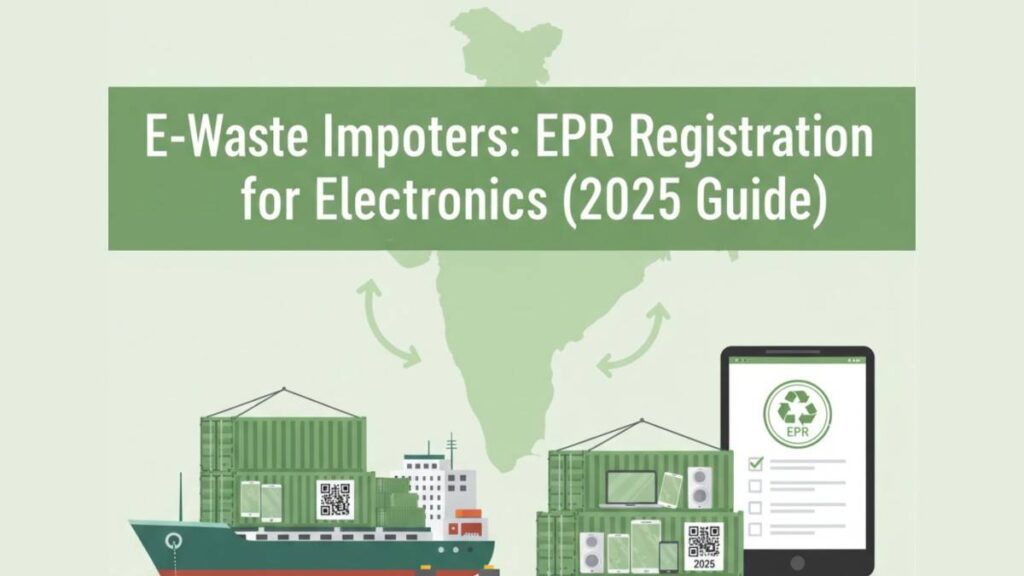- Home
- About Us
- Services
- Blogs
- Be our Partner
- Testimonials
- Contact Us
- Home
- About Us
- Services
- Blogs
- Be our Partner
- Testimonials
- Contact Us
If you import electronics into India — laptops, mobiles, tablets, home appliances, or even spare parts — you now fall directly under India’s E-Waste (Management) Rules, 2022, which became effective from April 1, 2023. These rules are stricter than ever before, and from July 2025, importers must also ensure barcoding/QR codes on packaging to validate their CPCB registration number.
For many importers, EPR compliance often seems like a maze of paperwork, CPCB portal uploads, and fee slabs. Yet, missing these obligations can result in penalties, suspension of imports, and even criminal liability under the Environment Protection Act, 1986.
This guide breaks down the importer-specific requirements for E-Waste EPR Registration — from documents, CPCB sign-up, fee structure, and annual returns, to the latest 2025 amendments.

Under the E-Waste Rules, “Producers” include not just manufacturers but also importers of electronics. This means every importer of Electrical and Electronic Equipment (EEE) must:
Without this registration, importers cannot legally sell or distribute electronics in India. State Pollution Control Boards (SPCBs) also conduct cross-checks to prevent unregistered imports.
Here’s how importers compare with other regulated entities:
| Entity | Authority for Registration | Fees | Obligations | Validity |
|---|---|---|---|---|
| Importer (Electronics EEE) | CPCB (if in >2 states), else SPCB | ₹2,500 to ₹15,00,000 depending on E-Waste generated/imported | Import data declaration, CPCB portal registration, barcode on packaging (from July 2025), quarterly & annual returns | 5 Years |
| Producer (Domestic Manufacturer/Marketer) | CPCB/SPCB | Same slabs as importers | Register EEE, ensure RoHS compliance, EPR targets, awareness campaigns | 5 Years |
| Brand Owner (Retailers/Private Labels) | CPCB/SPCB | Based on plastic waste generation (₹10,000–₹50,000) | Meet plastic EPR targets, coordinate with recyclers | 1–3 Years |
| Recycler | CPCB/SPCB | ₹15,000 for new recycler; ₹7,500 renewal | Process e-waste, issue EPR certificates for key metals (Gold, Cu, Al, Fe) | 5 Years |
Here’s a structured checklist importers must follow:
| Import Volume (MT/year) | CPCB Fee |
|---|---|
| < 50 MT | ₹2,500 |
| 50–100 MT | ₹7,500 |
| 100–1,000 MT | ₹1,50,000 |
| 1,000–5,000 MT | ₹10,00,000 |
| > 5,000 MT | ₹15,00,000 |
Note: New importers starting sales pay ₹10,000 flat fee.
In 2024, a European electronics importer registered with CPCB under the ₹7,500 fee slab (<100 MT). They imported laptops, tablets, and accessories into India.
Key actions they took:
Result: They avoided a ₹25 lakh penalty, ensured uninterrupted imports, and gained credibility with Indian distributors.
If importers fail to comply:
Any company or individual importing electrical & electronic equipment (EEE), including laptops, mobiles, home appliances, or components, must register with CPCB under the E-Waste Rules, 2022.
It ranges from ₹2,500 (<50 MT) to ₹15 lakh (>5,000 MT). New importers pay a flat ₹10,000 fee.
IEC, GST, PAN, CIN (if applicable), SPCB consents (if warehousing), CA certificate of imports, and authorized person details.
Suspension of registration, environmental compensation per MT, fines under the Environment Protection Act, and product seizures for barcode violations.
By purchasing EPR certificates from CPCB-registered recyclers, who issue credits against metals like copper, aluminum, iron, and gold.
Yes, importers of electronics packaged in plastic or with batteries must also comply with Plastic Waste Rules 2025 and Battery Waste Rules 2025.
India’s compliance landscape for electronics importers is tightening fast. With EPR registration, quarterly returns, and barcode mandates, importers can no longer afford to delay compliance.
Instead of treating this as a burden, forward-looking importers are using CPCB registration as a trust-building tool with distributors and customers. The ones who adapt early not only avoid penalties but also position themselves as sustainable and responsible players in India’s booming electronics market.
📧 Email: wecare@greenpermits.in
📞 Mobile: +91 78350 06182
Get Expert Support for Importer EPR Compliance →
Green Permits helps importers simplify CPCB/SPCB compliance, avoid penalties, and stay ahead of evolving EPR norms.